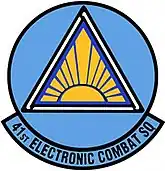41st Electronic Combat Squadron
 | |
|---|---|
 41st Electronic Combat Squadron EC-130H Compass Call 73-1581 | |
| Active | 1917–1946; 1954–1959; 1965–1969; 1980–present |
| Country | |
| Branch | |
| Role | Electronic warfare |
| Nickname(s) | Scorpions |
| Engagements | World War I Antisubmarine Campaign Vietnam War Desert Storm[1] |
| Decorations | Presidential Unit Citation Air Force Outstanding Unit Award with Combat "V" Device Air Force Outstanding Unit Award Republic of Vietnam Gallantry Cross with Palm[1] |
| Insignia | |
| 41st Electronic Combat Squadron emblem (approved 28 October 1981)[1] |  |
| 9th Airship Company emblem (approved 3 January 1933)[2][note 1] |  |
The 41st Electronic Combat Squadron is a United States Air Force unit. Its current assignment is with the 55th Electronic Combat Group at Davis–Monthan Air Force Base, Arizona as a geographically separated unit from its parent wing, the 55th Wing at Offutt Air Force Base, Nebraska. It operates the Lockheed EC-130H Compass Call communications-jamming aircraft.
The squadron is one of the oldest in the United States Air Force, its origins dating to 14 June 1917, when it was organized at Kelly Field, Texas. It served overseas in France as part of the American Expeditionary Forces during World War I. The squadron also saw combat during World War II, and became part of Tactical Air Command (TAC) during the Cold War.
History
World War I
The squadron's origins date to the 9th Balloon Company of the Observation Balloon Service in World War I, which served with the French 17th and 32nd Army Corps, and the III and IV Army Corps, United States Army, from 16 August – 11 November 1918.[1]
World War II
The squadron provided air defense for Panama Canal, January 1942 – May 1944, with occasional antisubmarine patrols over the Caribbean and Pacific, especially during May and June 1942; deployed to Western Pacific in June 1945, but never entered combat.[1]
Cold War
The squadron was reactivated at Shaw Air Force Base, South Carolina, where it was assigned to the 432d Tactical Reconnaissance Group and equipped with Douglas RB-26 Invader aircraft.[1] In 1956 as deliveries of the Douglas RB-66B Destroyer to the Air Force increased, the squadron was equipped with the newer jet aircraft.[3]
From the 1960s
The unit fought in Southeast Asia, c. November 1965 – 31 October 1969.[1]
The unit was tasked with command, control, and communications countermeasures from 1982 onwards. It flew electronic countermeasures missions from the United Arab Emirates during Operation Desert Shield/Operation Desert Storm from 27 August 1990 – 17 April 1991.[1]
Lineage
- Organized as Company A, 4th Balloon Squadron on 13 November 1917
- Redesignated 9th Balloon Company on 25 July 1918
- Redesignated 9th Airship Company on 30 August 1921
- Redesignated 9th Airship Squadron on 26 October 1933
- Redesignated 1st Observation Squadron on 1 June 1937
- Redesignated 1st Observation Squadron (Medium) on 13 January 1942
- Redesignated 1st Observation Squadron on 4 July 1942
- Redesignated 1st Reconnaissance Squadron (Special) on 25 June 1943
- Redesignated 41st Photographic Reconnaissance Squadron on 25 November 1944
- Redesignated 41st Tactical Reconnaissance Squadron on 24 January 1946
- Inactivated on 17 June 1946
- Redesignated 41st Tactical Reconnaissance Squadron, Night-Photographic on 14 January 1954
- Activated on 18 March 1954
- Inactivated on 18 May 1959
- Redesignated 41st Tactical Reconnaissance Squadron, Photo-Jet and activated on 30 June 1965 (not organized)
- Organized on 1 October 1965
- Redesignated 41st Tactical Reconnaissance Squadron on 8 October 1966
- Redesignated: 41st Tactical Electronic Warfare Squadron on 15 March 1967
- Inactivated on 31 October 1969
- Redesignated 41st Electronic Combat Squadron on 17 June 1980
- Activated on 1 July 1980[1]
Assignments
Source:[4]
|
|
Stations
|
|
Aircraft
- Type R observation balloon, 1918–1919,
- 1919–1921; probably included RN-1 (Zodiac), type SST (Mullion), type AA (pony blimp), A-4, D-4, OA-1, AC-1, TA-1, TA-5, TC-1, TC-3, TC-5, TC-6, TC-10, TC-11, TC-14, TE-1, type TE-3, and TF-1 nonrigid airships, RS-9 semirigid airship, type R (later, C-3) and C-6 observation balloons, and A-6, A-7, and A-8 spherical balloons during period 1922–1937.
- Thomas-Morse O-19, Douglas O-25, and apparently O-46, during period 1937–1939.
- O-47, 1938–1944, L-4 and B-18, 1942–1944,
- P-39, 1943–1944, included Kellett YG-1B, c. 1938–1940, YO-51 Dragonfly, 1940–1941, Bellanca YO-50, and apparently O-59 Grasshopper, 1941, O-49, 1941–1943, and CG-4, 1943; A-20, 1944, primarily F-5 Lightning, 1944–1946.
- Douglas RB-26 Invader, 1954–1956;
- Douglas RB-66 Destroyer, 1956–1959.
- Douglas RB-66 Destroyer, 1965; EB-66, 1965–1969.
- EC-130H Compass Call, 1982– [1]
See also
References
Notes
Explanatory notes
Footnotes
- 1 2 3 4 5 6 7 8 9 10 11 12 "Factsheet 41 Electronic Combat Squadron". Air Force Historical Research Agency. 22 March 2011. Retrieved 8 January 2017.
- ↑ Maurer, Combat Squadrons, pp. 191–192
- ↑ Knaack, p. 419
- ↑ "41 Electronic Combat Squadron". Air Force Historical Research Agency. Retrieved 3 March 2023.
- ↑ Gulf War Air Power Survey (PDF) (Report). Vol. V. Washington, D.C. 1993. p. 59. Retrieved 17 August 2022.
Bibliography
![]() This article incorporates public domain material from the Air Force Historical Research Agency
This article incorporates public domain material from the Air Force Historical Research Agency
- Knaack, Marcelle Size (1988). Encyclopedia of US Air Force Aircraft and Missile Systems. Vol. 2, Post-World War II Bombers 1945–1973. Washington, DC: Office of Air Force History. ISBN 0-912799-59-5.
- Maurer, Maurer, ed. (1982) [1969]. Combat Squadrons of the Air Force, World War II (PDF) (reprint ed.). Washington, DC: Office of Air Force History. ISBN 0-405-12194-6. LCCN 70605402. OCLC 72556.
.svg.png.webp)